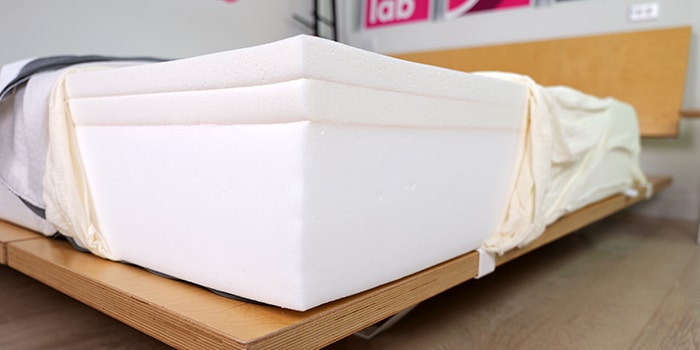
Best For
- Traditional memory foam feel
- Lower levels of bounce
- Slow material response time
- Lower levels of motion transfer
Considerations
- Priced 75% more than the average memory foam mattress
- Performs in the bottom 8% of all mattresses tested to date
- Only a 90-night trial period and returns cost you $175
Our Verdict
The Tempurpedic Cloud mattress is a 10″ memory foam mattress made of a 3.0″ memory foam comfort layer and a 7.0″ support foam layer. Despite the hype and brand loyalty around the Tempurpedic name, when we look at the inside, the Cloud is a fairly basic memory foam mattress.
The mattress offers moderate levels of sinkage and very low levels of bounce. It has a classic memory foam feel with a slower response time and all the properties of a more traditional memory foam.
The mattress is available in a single firmness, 6 out of 10, which gives the mattress a medium-firm feel.
In our performance tests, the Tempurpedic Cloud had a performance score of 7.63, ranking in the bottom 11% of all mattresses tested to date.
Despite the higher price, Tempurpedic still has a price tag that is 75% more expensive than the average memory foam mattress (based on all of our tests to date), costing sleepers an extra $854 for a queen mattress.
After comparing over 350+ mattresses to date, I can say with confidence that there are many other memory foam mattress alternatives with better performance and a lower price tag than the Tempurpedic Cloud. See our best memory foam mattress rankings for more.
Given the price to performance ratio, I don’t think there is any compelling reason to purchase this model. There are simply a large number of other mattresses with similar or better performance that cost significantly less.
Type: Memory Foam
Firmness: Medium-Firm (6)
Best For: All Sleeping Positions, All Body Weights
In This Review
Performance Tests | Firmness | Support & Sleeping Positions | Design | Materials | Comparisons | FAQs
Performance Tests
At NapLab, we put each mattress to the test.
We test 10 different factors that impact the performance, comfort, and feel of the mattress. We then take the results of that test and compare to every mattress we’ve tested to date.
Check out the full performance table below to see how this mattress ranks:
| Factor | Tempurpedic Cloud | Average |
|---|---|---|
| Overall Score | 7.63 | 8.55 |
| Price (Queen) | $1,999 | $1,145 (Memory Foam only) |
| Cooling – Score | 8.0 | 8.7 |
| Sinkage – Depth | 2.11″ | 2.15″ |
| Sinkage – Feel | Moderate | Moderate |
| Motion Transfer – Score | 8.7 | 8.2 |
| Motion Transfer – Acceleration | 7.88 m/s² | 8.80 m/s² |
| Response Time – Score | 5.0 | 8.9 |
| Response Time – Mostly Recovered | 3.8 sec. | 0.4 sec. |
| Response Time – Fully Recovered | 8.0 sec. | 0.9 sec. |
| Bounce – Height | 4.47″ | 9.50″ |
| Bounce – Feel | Very Low | Moderate |
| Edge Support – Score | 7.4 | 8.6 |
| Edge Support – Sitting | 4.75″ | 4.05″ |
| Edge Support – Lying | Fair | Good |
| Sex – Score | 6.4 | 8.4 |
| Pressure Relief – Score | 9.0 | 8.7 |
| Comfort Layer Thickness | 3.0″ | 4.1″ |
| Mattress Thickness | 10″ | 12.0″ |
| Off-Gassing – Score | 8.1 | 8.2 |
| Off-Gassing – Smell | Strong | Strong |
| Off-Gassing – Days | 7 days | 6 days |
| Company – Score | 6.4 | 8.8 |
| Trial | 90 nights | 177 nights |
| Warranty | 10 years | 26% have lifetime warranties, average of other 74% of mattresses is 13 years |
How is Tempurpedic Cloud Different?
The Tempurpedic Cloud mattress has an overall score that is lower than the average performance score comparing all mattresses tested to date. In addition, the Tempurpedic also has a price tag that is above average—an increase of 75% over the average memory foam mattress, based on all of our tests to date.
Advantages
The only real advantage of the Tempurpeidc Cloud mattress over the average memory foam mattress is slightly less motion transfer than average.
Neutral Factors
This mattress has moderate sinkage and very low levels of bounce. This is a pretty classic memory foam feel and not necessarily an advantage or disadvantage.
Disadvantages
Specific disadvantages of the Cloud include good, but not great cooling performance, slow material response time, and worse edge support.
Because of the lower bounce and worse edge support, sex performance also really struggles with a performance score of 2 full points less than the average sex score (6.4 vs. 8.4).
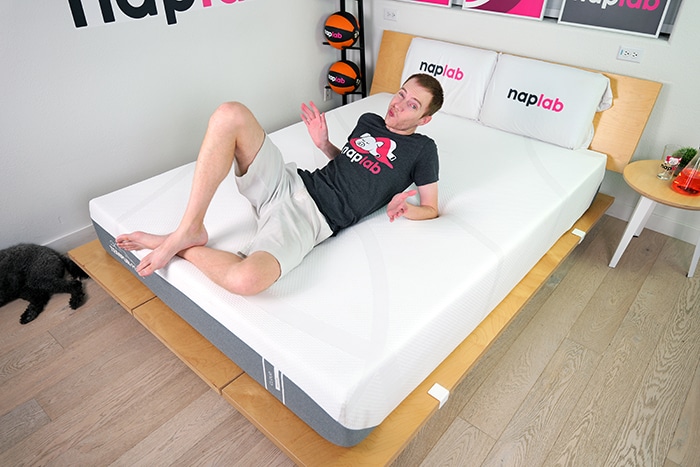
Cooling Test
The Tempurpedic Cloud has good cooling. During our tests, I felt a slight to moderate level of heat retention around my body.
Baseline Temp.
74.1° F
Max Temp.
89.5° F
Ending Temp.
82.6° F
This is a pretty typical memory foam experience when it comes to cooling. Cooling isn’t bad by any stretch, but the all-foam design simply doesn’t breathe as well as other mattress types.
Max Temp.
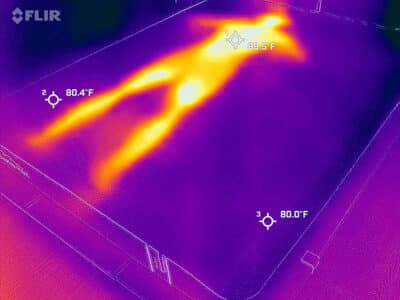
Ending Temp
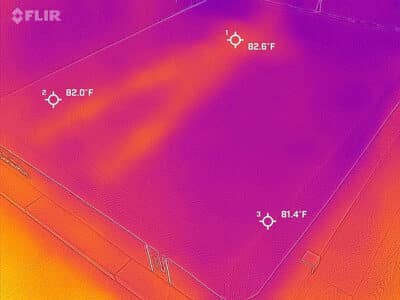
- Baseline Temperature – the temperature of the mattress before anyone lies on it
- Maximum Temperature (0 minute) – the temperature of the mattress after lying on it for 15 minutes
- Ending Temperature (5 minute) – the temperature of the mattress after being lied upon and having no one on it for 5 minutes
In addition, memory foam also struggles more to release heat compared to latex and many types of poly foam.
Heat Dissipation Over Time
In our objective temperature tests, we measured a max surface level temperature of 89.5° F. This is 0.2° less than the average of 89.7° F, based on all of our tests to date.
After getting off the mattress the temperature declined by 2.5° from minutes 0 to 1, which is 2.2° warmer than the average 0 to 1 minute decline, based on all of our tests to date.
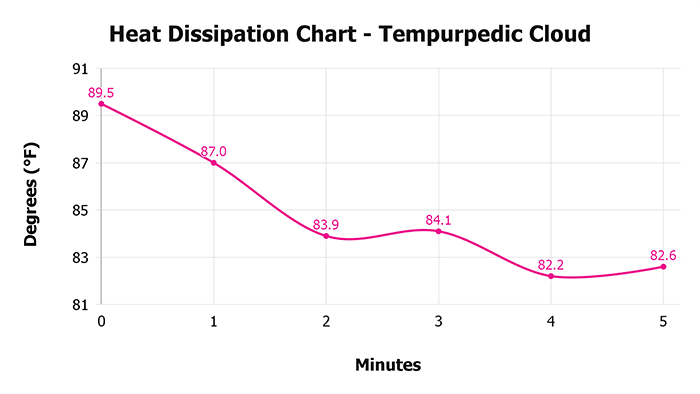
While I was pleased to see the max temperature kept to a reasonable level, the worse-than-average heat dissipation performance after we got off the mattress certainly leaves much to be desired.
When we consider the combination of objective data, my subjective experiences, and an analysis of the materials, I’m confident in my view that cooling is good.
Sinkage Test
The Tempurpedic Cloud has moderate sinkage. During our tests, we measured a pressure point sinkage depth of 2.11″. This is 0.04″ less sinkage than the average sinkage depth of 2.15″, based on all of our tests to date.
Sinkage Depth
2.11″
Sinkage Feel
Moderate
Body Contour
Dramatic
The level of sinkage is documented in the image below.
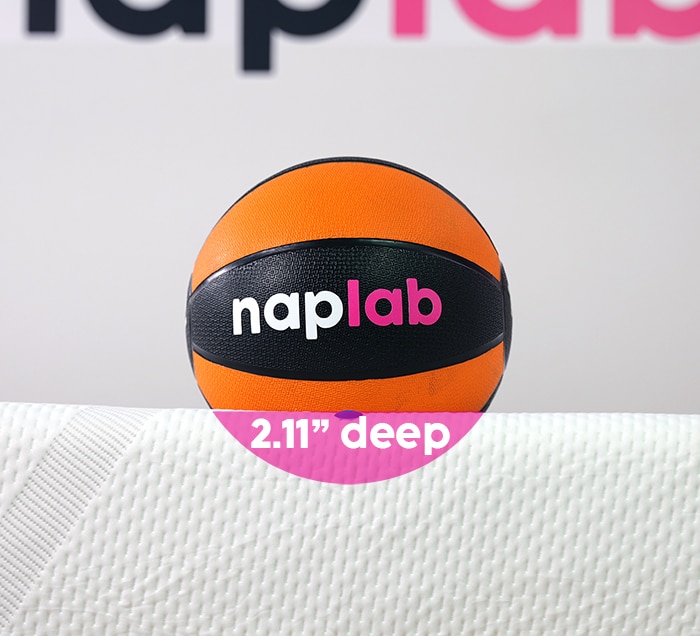
The mattress creates a traditional memory foam feel. There is a dramatic body contouring hug that conforms to the exact shape of your body.
This type of a hug, combined with the incredibly slow material responsiveness, makes it more difficult to move around the mattress and change positions during the night.
For many sleepers, this could cause you to feel more “stuck” in the mattress as it creates a body impression crater that’s harder to move out of.
Motion Transfer Test
The Tempurpedic Cloud has a low level of motion transfer. During our tests, we measured a total acceleration range of 7.88 m/s². This is 10% less motion transfer than the average of 8.80 m/s².
Accel. Range
7.88 m/s²
Motion Duration
0.47 seconds
If there is one area that memory foam typically excels in, it’s motion transfer. The slower material responsiveness, harder feel when you first lie down, and low bounce are all working together to keep motion transfer held to a below-average level.
The level of motion transfer is also documented in the video below.
In our motion transfer chart, which visualizes our accelerometer data, we can see the highest motion peaks from 0 to 0.14 seconds. Motion declines thereafter and we see a small secondary spike around 0.36 seconds.
By 0.47 seconds we’ve returned to near-zero levels of energy. Both the motion spikes and motion duration are notably better than average.
Based on our objective testing data, I expect most sleepers will find the low motion to be more than satisfactory.
Motion Transfer Over Time
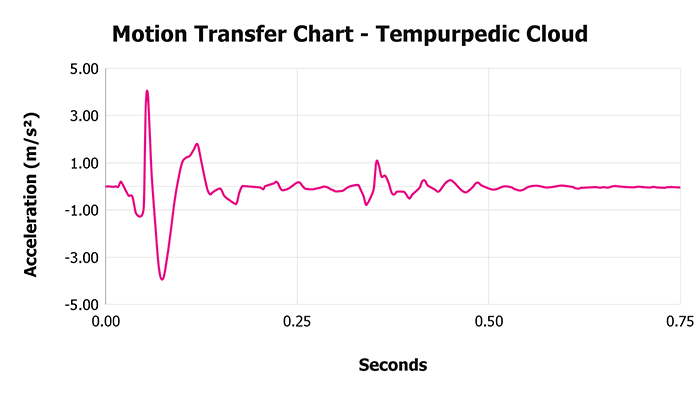
Response Test
The Tempurpedic Cloud has a very slow material response. In our mostly recovered test, we measured a recovery speed of 3.8 seconds, which is 3.39 seconds slower than the average of 0.41 seconds, based on all of our tests to date.
Mostly Recovered
3.8 sec.
Complete Recovery
8.0 sec.
In our fully recovered responsiveness test, we measured a recovery speed of 8.0 seconds, 7.08 seconds slower than the average of 0.92 seconds. There is simply no sugarcoating it—the Tempurpedic Cloud is among the worst mattresses we’ve ever tested for material responsiveness.
The Cloud earned the #2 worst-ranked spot for its mostly recovered speed and the #1 worst-ranked spot for its full recovered speed (narrowly beating out the Tempurpedic Supreme from Costco with its 7.8-second material recovery).
The level of responsiveness is documented in the video below.
The slow material responsiveness makes it more difficult to move around on the mattress, change positions, engage in amorous activities, and get in and out of bed. If you’re considering this model you should be absolutely certain that you are more than okay with the slow responsiveness.
Bounce Test
The Tempurpedic Cloud has a very low level of bounce. During our tests, we measured a total bounce height of 4.47″. This is 5.03″ less bounce than the average of 9.50″, based on all of our tests to date.
Max. Depth
4.04″
Max. Rebound
0.43″
Total Bounce
4.47″
The all-foam design and thick 3.0” memory foam comfort layer greatly absorb bounce, while also failing to return any significant levels of energy. This greatly helps to reduce motion transfer. However, it also has significant negative impact on sex performance and makes the mattress more difficult to move around on.
Max. Sinkage Depth
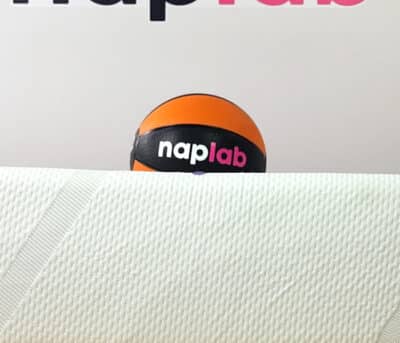
Max Bounce Height
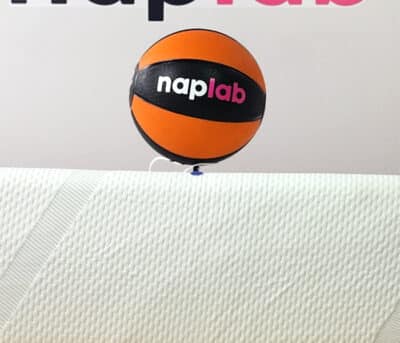
The level of bounce is also documented in the video below.
Ideally, I want to see 8-12” of total bounce. Suffice it to say, at 4.47” of bounce the Tempurpedic Cloud is nowhere near those levels.
The low bounce is just one among many factors that make more traditional memory foam a more polarizing feel. Some sleepers like this type of feel, but a large majority (in my view) will simply find it just isn’t comfortable.
Edge Support Test
The Tempurpedic Cloud has fair sitting edge support and fair lying edge support. In our sitting edge support test, we measured a sitting sinkage compression of 4.75″. This is 0.70″ more sitting sinkage than the average of 4.05″, based on all of our tests to date.
Max. Sinkage
4.75″
Lying Support
Fair
Reinforced Edge
No
While sitting directly on the edge I felt reasonably well supported. However, it’s also clear that sitting support could have been better.
The level of edge support while seated is documented in the images below.
Sitting, 140 lbs.

Sitting, 200 lbs.
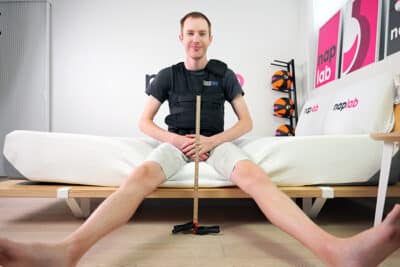
It’s a similar story with lying edge support. While lying directly on the edge of the mattress, I felt that the support was fair in all sleeping positions and I did not feel tremendously well supported. The problem with edge support is the body contouring hug of the memory foam.
The level of edge support while lying is documented in the images below.
Lying on Edge, 140 lbs.
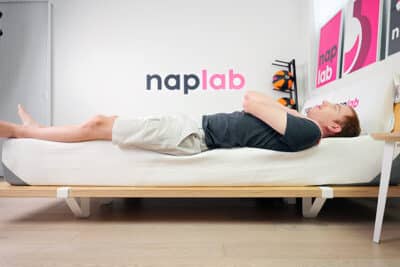
Lying on Edge, 200 lbs.
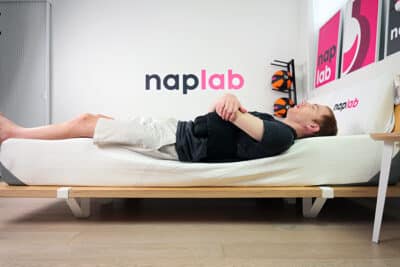
When in the middle of the mattress the extra hug is great. However, when the foam contours at the edge of the mattress it creates a weakening of support along the edge. For this reason, support just isn’t ideal at the edge.
Sex Test
The Tempurpedic Cloud has mediocre sex performance. On the positive side, pressure relief is excellent, cooling is good enough, and noise is minimal due to the all-foam design. However, that’s where the benefits end.
| Sex Factor | Factor Weight | Score | Rating |
|---|---|---|---|
| Bounce | 65% | 5.3 | Very Low |
| Edge Support | 20% | 7.8 | Fair |
| Noise | 5% | 10 | Minimal |
| Pressure Relief | 5% | 9.0 | Excellent |
| Cooling | 5% | 8.0 | Good |
Edge support was fine, but also far from great. At 4.75” of sitting edge sinkage it’s notably worse than the average of 4.05”, based on all of our tests to date.
Even so, it would have been good enough had the bounce been higher. In our tests, we measured 4.47” of total bounce height. This is massively less than the average bounce height of 9.50”.
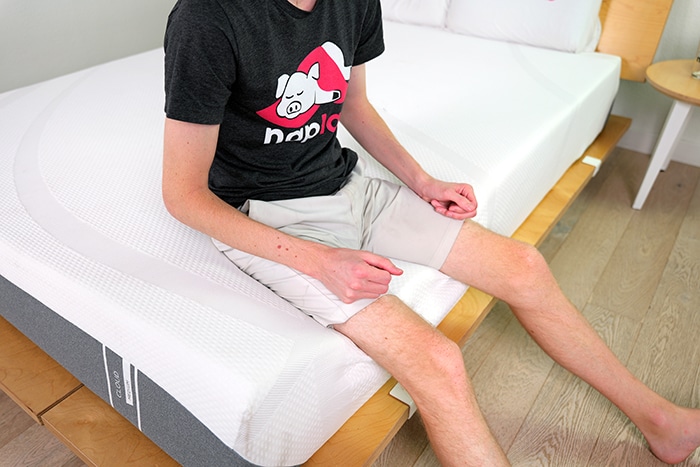
When it comes to amorous activities, more bounce is always better. Needless to say, the Tempurpedic Cloud is extremely lacking with respect to bounce. The lower bounce is great for reducing motion transfer, however, it is also the single biggest factor that negatively impacts sex performance.
Pressure Relief Test
The Tempurpedic Cloud has an excellent level of pressure relief. During our tests, I felt no significant level of pressure points anywhere on my body. The mattress creates a great comfort dynamic, provided you like the feel of memory foam.
Comfort Layer
3.0″
Support Layer
7.0″
It really is that more polarizing feel of memory foam that fundamentally determines if this mattress is a good fit or not. With the Cloud, we have more body contouring hug, a slower material response, and low bounce.
For some sleepers, that dynamic creates great pressure relief. Even so, it also makes it harder to move around on the mattress and can cause many sleepers to feel “stuck” in the mattress due to the body contouring.
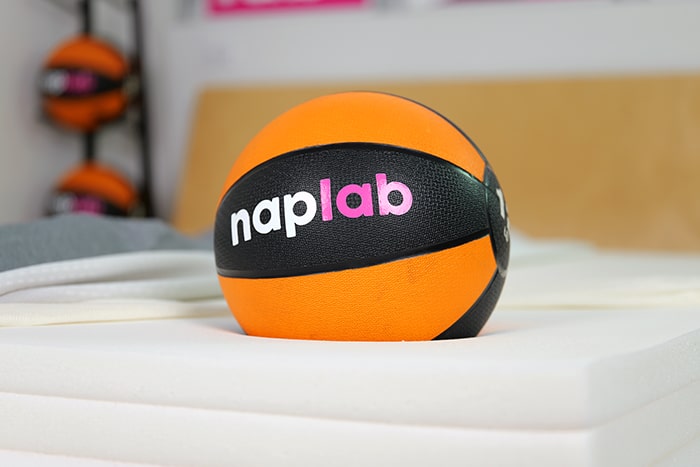
The mattress uses 3.0” of comfort foam via two 1.5” memory foam layers. This is notably less than the average comfort layer thickness of 4.13”, based on all of our tests to date.
Even so, the quality of the foams is solid, so they still are able to create excellent pressure relief.
Lastly, in our pressure mapping tests we measured a max PSI of 0.89. This is extremely low pressure. A PSI of 2.0 is considered a high pressure point and no point on the Tempurpedic Cloud comes near those levels. In all 3 pressure mapping tests there were no notable levels of pressure anywhere.
When I consider the material thickness, material quality, objective pressure mapping tests, and my subjective experience on the mattress, I’m confident most sleepers will find the pressure relief to be excellent.
Pressure Map – Side Sleepers
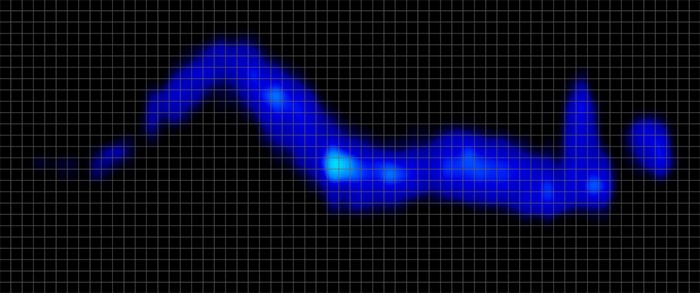
| Pressure Relief (PSI) | Average | Maximum |
|---|---|---|
| Side Sleepers | 0.17 | 0.89 |
Pressure Map – Back Sleepers
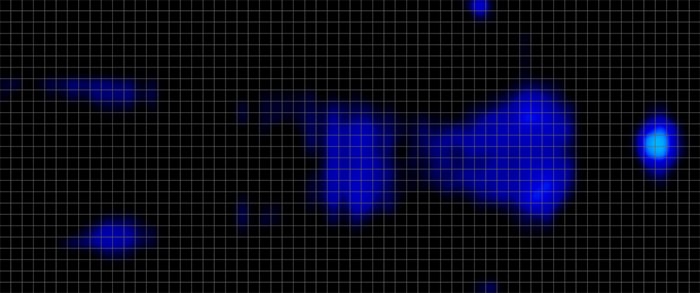
| Pressure Relief (PSI) | Average | Maximum |
|---|---|---|
| Back Sleepers | 0.10 | 0.73 |
Pressure Map – Stomach Sleepers
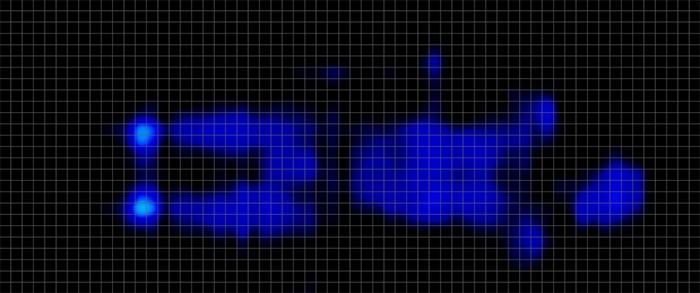
| Pressure Relief (PSI) | Average | Maximum |
|---|---|---|
| Stomach Sleepers | 0.11 | 0.73 |
Off-Gassing Test
Off-gassing on the Tempurpedic Cloud is strong right out of the box and the odor took 7 days to fully dissipate.
Initial Smell Strength
Strong
Off-Gassing Period
7 days
Comparing over 270+ mattresses tested to date, the average off-gassing period is 6 days.
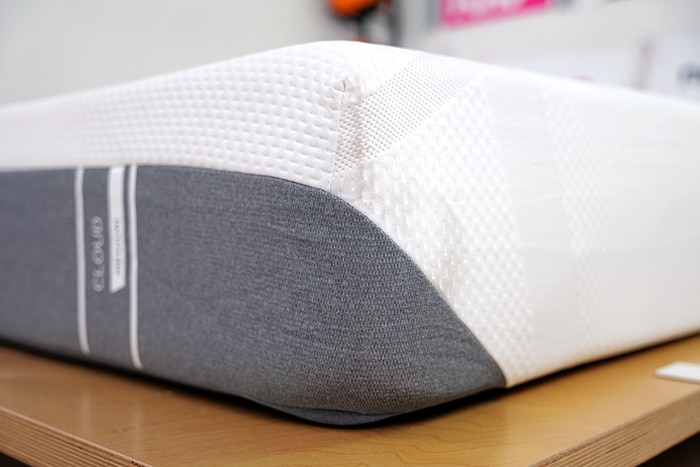
Company
Tempurpedic has been around for over 30 years and is known for high-end luxury memory foam mattresses. However many parts of its company policies were lacking when compared to many other mattress brands.
The brand offers a 90-night trial period and a 10-year warranty. Shipping is free, but if you don’t love the mattress, it’ll cost you $175 to return the mattress. Return fees are fairly uncommon, with only 18% of mattresses we’ve tested charging a return fee. Of those brands that do charge a return fee Tempurpedic is tied for the most expensive at $175.
| Company Factor | Factor Weight | Score | Data |
|---|---|---|---|
| Returns | 40% | 5.0 | $175 |
| Trial Period | 30% | 6.0 | 90 nights |
| Warranty | 20% | 8.0 | 10 years |
| Shipping | 10% | 10 | $0 |
| Country of Origin | 0% | USA |
Tempurpedic’s website says that they “typically” ship in 7-10 days, but due to high-demand shipping can take 3-5 weeks “depending on product selection”.
For reference, the average trial is 177 nights and the average warranty is 13 years. Among all mattresses we’ve tested, 24% of mattresses have lifetime warranties.
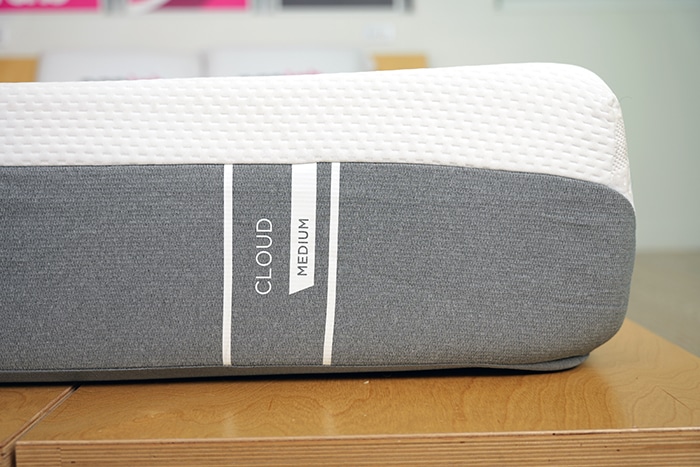
How firm is Tempurpedic Cloud?
The Tempurpedic Cloud mattress is available in a single firmness, 6 out of 10, which gives the mattress a medium-firm feel.

Support & Sleeping Positions
Support on the Tempurpedic Cloud is excellent. During our tests, I felt well-supported in all sleeping positions.
| Support Factor | Data |
|---|---|
| Comfort Layer | 3.0″ |
| Support Layer | 7.0″ |
| Firmness | Medium-Firm |
| Body Contour | Dramatic |
| Zoned Support | No |
| Reinforced Edge | No |
The mattress is equipped with a 7.0″ support layer. This is 0.89″ thinner than the average support layer thickness of 7.89″, based on all of our tests to date.
The 10.0″ of total height on the Tempurpedic Cloud is on the thinner side, being 2.0” thinner than average mattress based on all of our tests to date.
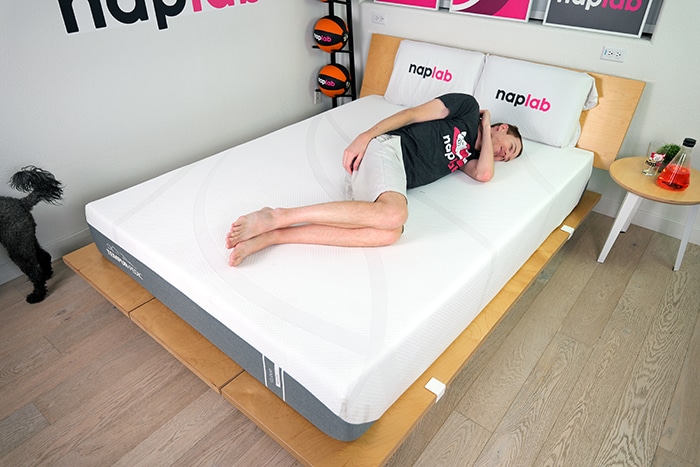
Even so, the relative quality and density of the foam layers means they are still able to create robust support for sleepers.
As with pressure relief, whether or not you feel well-supported comes down to whether or not you like the feel of memory foam. As we mentioned before, this is more traditional memory foam and more traditional memory foam has a more polarizing feel.
Check out the table below to see the sleeper weights and sleeping positions that would be best suited for this mattress.
| Sleeper Weight | Stomach Sleepers | Side Sleepers | Back Sleepers |
|---|---|---|---|
| Under 150 lbs. | Yes | Yes | Yes |
| 150-250 lbs. | Yes | Yes | Yes |
| 250-300 lbs. | Yes | Yes | Yes |
If you like a more dramatic body contouring hug, a harder feel that gradually softens as it contours, slow material response, and lower bounce then you will likely find the Tempurpedic Cloud creates a support dynamic that works well for you.
Based on all of my tests to date, an analysis of the materials, and my subjective experiences, I’m confident in my view that support on the Tempurpedic Cloud is excellent.
Design
The Tempurpedic Cloud is a 10″ memory foam mattress, designed to be the entry-level Tempurpedic experience. It is the lowest-priced mattress on their website and also has the most basic design.
| Design Factor | Data |
|---|---|
| Type | Memory Foam |
| Thickness | 10.00″ |
| Cover Type | Thin |
| Weight | 57 lbs. |
| Has Handles | No |
| Fiberglass-Free | No |
| Ships in a Box | Yes |
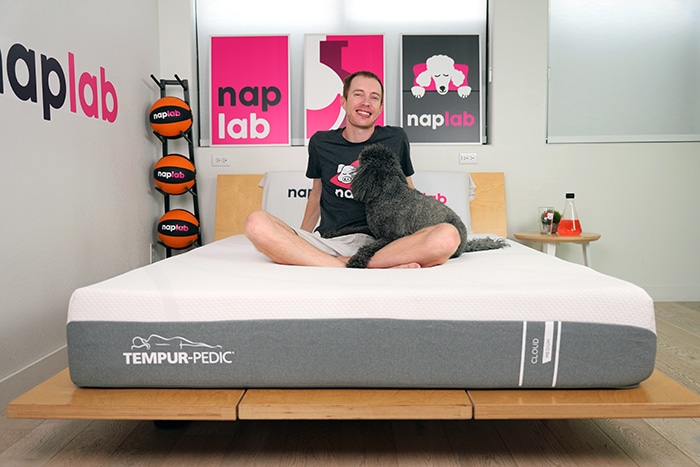
Materials
The Cloud mattress is made up of three layers of foam. The top two are for comfort and transitional support and the base is for support only.
From top to bottom, the layers include:
| Layer Type | Thickness | Layer Specs |
|---|---|---|
| Memory Foam | 1.0″ | Not Available |
| Memory Foam | 1.5″ | Not Available |
| Support Foam | 7.0″ | Not Available |
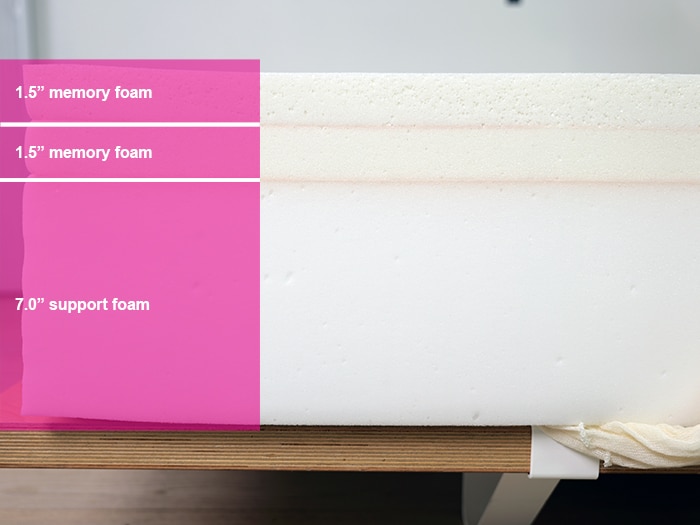
The Law Tag outlines the full breakdown of materials included in this mattress.
- Materials
- 69% polyurethane foam pad
- 31% visco elastic polyurethane foam pad
- Cover
- 98% Polyester
- 2% spandex
- Side
- 98% polyester
- 2% spandex
- Bottom
- 100% polyester
- Netting
- 47% rayon
- 23% glass fiber
- 15% polyester
- 11% modacrylic
- 4% nylon
- Made for: TEMPUR-PEDIC Management LLC 1000 TEMPUR Way Lexington, KY 40511
- Date of Delivery:
- Finished Size: 80 x 60 x 10 in.
- Net weight of filling mat: 68 lbs.
- Manufactured by: TEMPUR Production USA, LLC 203 Comfort Dr Duffield, VA 24244
- Date of Manufacture: 9/16/2024
The Cover
The cover of the Tempurpedic Cloud is a thin, moisture-wicking cover. It is designed to promote breathability (although the cooling performance score of 8.0 is still well below the average score of 8.7).
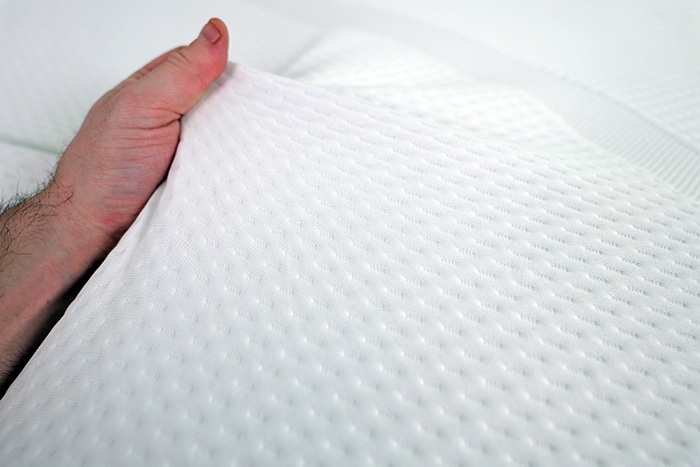
The Comfort Layer
The comfort layer is made of two 1.5″ memory foam layers. According to Tempurpedic, the top foam is designed to be “soft and responsive” while the secondary foam is a firmer support foam.
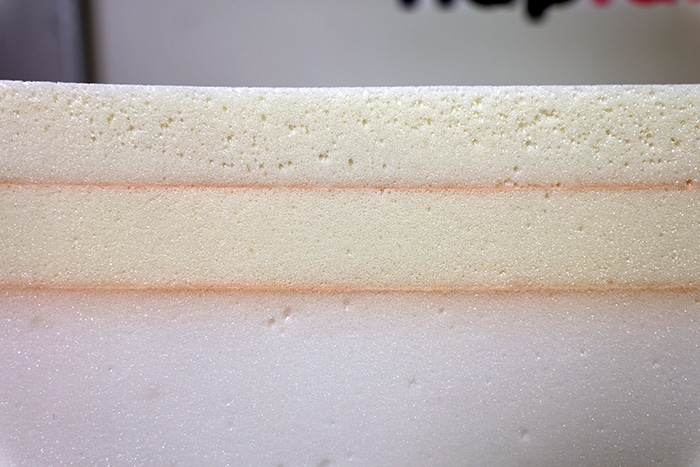
The Support Layer
The support layer is a 7.0″ thick high-density support base foam. This layer is designed specifically for support and is typical for all-foam mattresses.
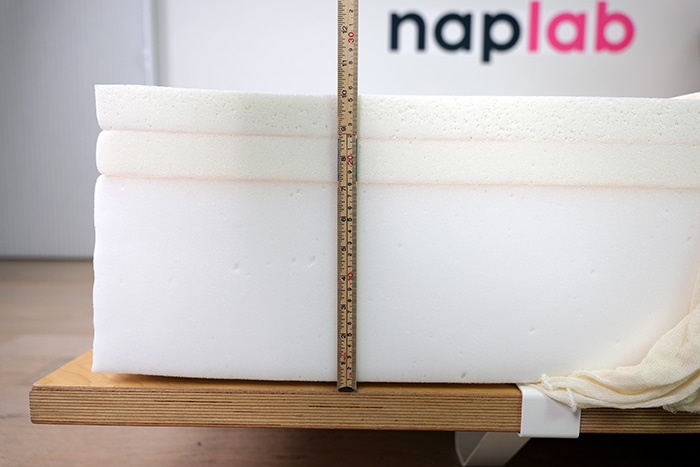
Product Evolution
Tempurpedic first started selling mattresses in 1992. The original Tempurpedic memory foams were more traditional by today’s modern standards.
They were extremely slow to respond, slept hot, had very little bounce, and created dramatic contour.
Today, Tempurpedic manufactures a mix of all-foam and hybrid mattresses. The hybrids contain a pocketed coil base, which helps create faster response time and better edge support.
But concerning the Cloud model we tested here, it maintains more of the traditional feel that Tempurpedic’s were originally known for. If you’re looking for that very traditional feel, the Cloud could be a good option but if you’re worried about sleeping warm, slow response time, or feeling stuck, the Cloud is likely not your best option.
Other Mattresses to Consider
Not sure if the Tempurpedic Cloud is the right pick for you? Check out these three other top-rated memory foam mattresses for alternatives you may want to consider.
For Performance
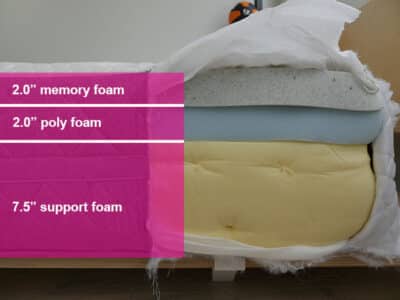
GhostBed Luxe
Medium-Firm Foam
The GhostBed Luxe is the highest-performing memory foam mattress we’ve tested to date. It is 13″ thick with extremely deep sinkage and moderate levels of bounce. This mattress has a medium-firm feel which generally suits the needs of a wide range of sleepers. This mattress is under $1600 for a queen, $400 less than the Tempurpedic Cloud.
For Softer Feel
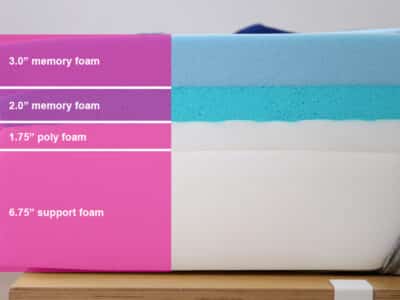
Amerisleep AS5
Modern Memory Foam Feel
The Amerisleep AS5 is a 14″ memory foam mattress with fantastic performance. It has a soft feel which can be especially beneficial to lighter-weighted side sleeers. There is a robust 6.75″ comfort layer and exceptional pressure relief.
For Minimal Sinkage
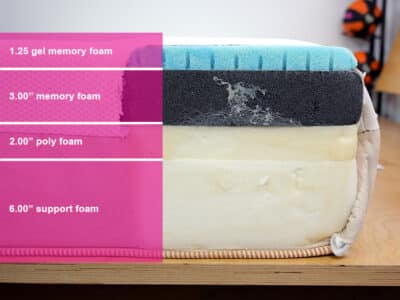
Saatva Contour5
Multi-Firmness Options
The Saatva Contour5 is a 12.25″ memory foam mattress with minimal sinkage and very low levels of bounce. It is available in two firmness options—medium-firm (6) and firm (8). The only disadvantage to the Saatva is higher levels of motion transfer and low bounce may be less ideal for good sex performance.
Frequently Asked Questions
Still have questions? Check out some of the top FAQs on the Tempurpedic Cloud mattress below and get the answers you’re looking for.
Here are the current prices, with any sales or promotions reflected below:
Twin: $1,699
Twin XL: $1,699
Full: $1,899
Queen: $1,999
King: $2,399
Cal. King: $2,399
*Note: Sales prices are subject to change without notice or warning.



